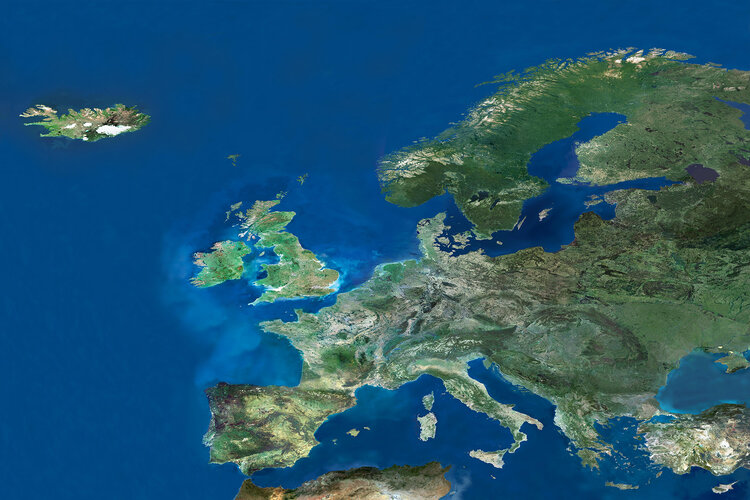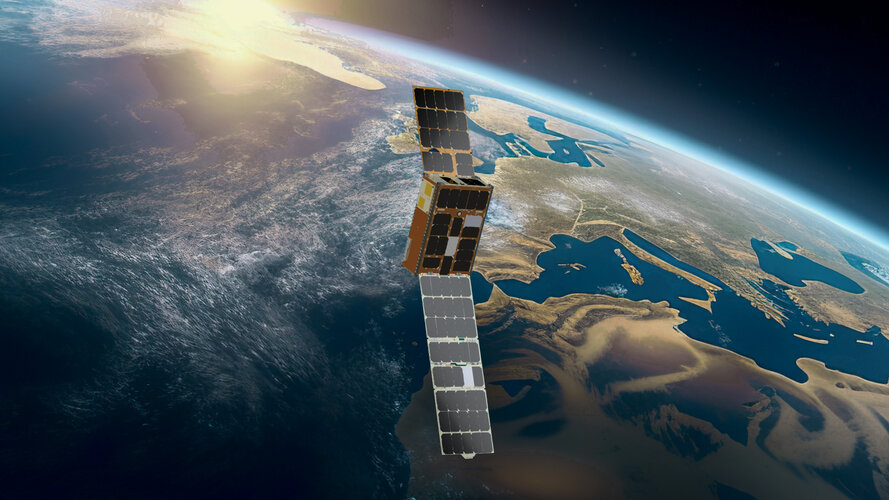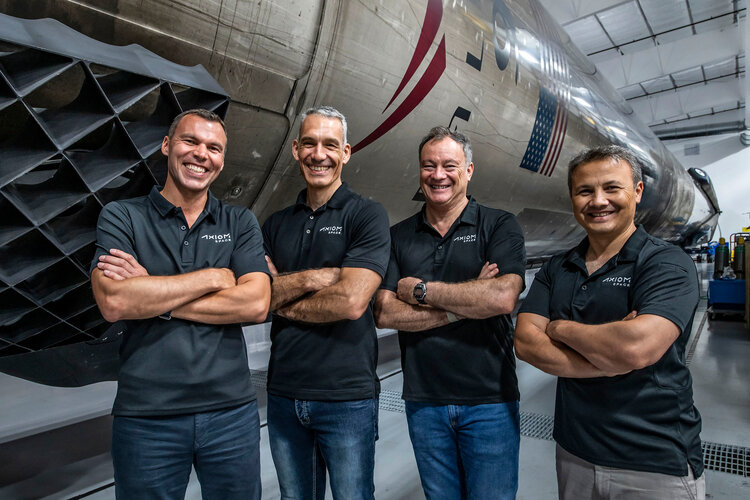
Copernical Team
Thursday, 14 December 2023 10:11
Spire Global secures major EUMETSAT contract for satellite weather data
Berlin, Germany (SPX) Dec 13, 2023
 Spire Global, Inc. (NYSE: SPIR), a leader in space-powered data and analytics, has been awarded a significant contract by EUMETSAT, the European meteorological satellite agency. This multi-million euro deal, spanning an initial period of two years from 2024 to 2026 with potential extensions, marks a significant step in advancing weather forecasting capabilities.
The contract, which include
Spire Global, Inc. (NYSE: SPIR), a leader in space-powered data and analytics, has been awarded a significant contract by EUMETSAT, the European meteorological satellite agency. This multi-million euro deal, spanning an initial period of two years from 2024 to 2026 with potential extensions, marks a significant step in advancing weather forecasting capabilities.
The contract, which include
 Spire Global, Inc. (NYSE: SPIR), a leader in space-powered data and analytics, has been awarded a significant contract by EUMETSAT, the European meteorological satellite agency. This multi-million euro deal, spanning an initial period of two years from 2024 to 2026 with potential extensions, marks a significant step in advancing weather forecasting capabilities.
The contract, which include
Spire Global, Inc. (NYSE: SPIR), a leader in space-powered data and analytics, has been awarded a significant contract by EUMETSAT, the European meteorological satellite agency. This multi-million euro deal, spanning an initial period of two years from 2024 to 2026 with potential extensions, marks a significant step in advancing weather forecasting capabilities.
The contract, which include
Published in
News
Tagged under
Thursday, 14 December 2023 10:11
Eutelsat OneWeb set to revolutionize Libyan telecommunication services
London, UK (SPX) Dec 14, 2023
 Eutelsat Group (Paris:ETL) (LSE:ETL), a global satellite communications leader and the first to operate both Geostationary (GEO) and Low Earth Orbit (LEO) satellites, has announced a groundbreaking exclusive distribution agreement with Rawafed Libya for Telecommunications and Technology (RLTT), a prominent Libyan telecom operator. This partnership, which marks a significant expansion in Eutelsat
Eutelsat Group (Paris:ETL) (LSE:ETL), a global satellite communications leader and the first to operate both Geostationary (GEO) and Low Earth Orbit (LEO) satellites, has announced a groundbreaking exclusive distribution agreement with Rawafed Libya for Telecommunications and Technology (RLTT), a prominent Libyan telecom operator. This partnership, which marks a significant expansion in Eutelsat
 Eutelsat Group (Paris:ETL) (LSE:ETL), a global satellite communications leader and the first to operate both Geostationary (GEO) and Low Earth Orbit (LEO) satellites, has announced a groundbreaking exclusive distribution agreement with Rawafed Libya for Telecommunications and Technology (RLTT), a prominent Libyan telecom operator. This partnership, which marks a significant expansion in Eutelsat
Eutelsat Group (Paris:ETL) (LSE:ETL), a global satellite communications leader and the first to operate both Geostationary (GEO) and Low Earth Orbit (LEO) satellites, has announced a groundbreaking exclusive distribution agreement with Rawafed Libya for Telecommunications and Technology (RLTT), a prominent Libyan telecom operator. This partnership, which marks a significant expansion in Eutelsat
Published in
News
Tagged under
Thursday, 14 December 2023 10:11
NASA's Webb identifies tiniest free-floating brown dwarf
University Park PA (SPX) Dec 14, 2023
 Using NASA's James Webb Space Telescope, astronomers have identified the new record-holder for the smallest object that forms like a star: a tiny, free-floating brown dwarf with only three to four times the mass of Jupiter.
Brown dwarfs are objects that straddle the dividing line between stars and planets. They form like stars, growing dense enough to collapse under their own gravity, but
Using NASA's James Webb Space Telescope, astronomers have identified the new record-holder for the smallest object that forms like a star: a tiny, free-floating brown dwarf with only three to four times the mass of Jupiter.
Brown dwarfs are objects that straddle the dividing line between stars and planets. They form like stars, growing dense enough to collapse under their own gravity, but
 Using NASA's James Webb Space Telescope, astronomers have identified the new record-holder for the smallest object that forms like a star: a tiny, free-floating brown dwarf with only three to four times the mass of Jupiter.
Brown dwarfs are objects that straddle the dividing line between stars and planets. They form like stars, growing dense enough to collapse under their own gravity, but
Using NASA's James Webb Space Telescope, astronomers have identified the new record-holder for the smallest object that forms like a star: a tiny, free-floating brown dwarf with only three to four times the mass of Jupiter.
Brown dwarfs are objects that straddle the dividing line between stars and planets. They form like stars, growing dense enough to collapse under their own gravity, but
Published in
News
Tagged under
Thursday, 14 December 2023 10:11
UK's Orbex secures funding for carbon-neutral spaceport development
Forres, UK (SPX) Dec 13, 2023
 In a significant step towards advancing sustainable spaceflight, UK-based Orbex has secured a GBP3.3 million grant from the UK Space Agency as part of the European Space Agency's (ESA) Boost! initiative. This initiative is a component of ESA's Commercial Space Transportation Services and Support program, aimed at propelling the development of leading-edge space launch technologies.
This su
In a significant step towards advancing sustainable spaceflight, UK-based Orbex has secured a GBP3.3 million grant from the UK Space Agency as part of the European Space Agency's (ESA) Boost! initiative. This initiative is a component of ESA's Commercial Space Transportation Services and Support program, aimed at propelling the development of leading-edge space launch technologies.
This su
 In a significant step towards advancing sustainable spaceflight, UK-based Orbex has secured a GBP3.3 million grant from the UK Space Agency as part of the European Space Agency's (ESA) Boost! initiative. This initiative is a component of ESA's Commercial Space Transportation Services and Support program, aimed at propelling the development of leading-edge space launch technologies.
This su
In a significant step towards advancing sustainable spaceflight, UK-based Orbex has secured a GBP3.3 million grant from the UK Space Agency as part of the European Space Agency's (ESA) Boost! initiative. This initiative is a component of ESA's Commercial Space Transportation Services and Support program, aimed at propelling the development of leading-edge space launch technologies.
This su
Published in
News
Tagged under
Thursday, 14 December 2023 10:11
Rocket Lab Sets Launch Date for iQPS's 'The Moon God Awakens' Mission
Sydney, Australia (SPX) Dec 14, 2023
 In a significant development in the realm of space launches and Earth observation, Rocket Lab USA, Inc. (NASDAQ: RKLB), a global leader in launch services, is gearing up for its 42nd Electron mission. Scheduled no earlier than December 15, 2023, between 17:00 - 19:00, the mission, aptly named "The Moon God Awakens," is set to lift off from Pad B at Rocket Lab's Launch Complex 1 in New Zealand. T
In a significant development in the realm of space launches and Earth observation, Rocket Lab USA, Inc. (NASDAQ: RKLB), a global leader in launch services, is gearing up for its 42nd Electron mission. Scheduled no earlier than December 15, 2023, between 17:00 - 19:00, the mission, aptly named "The Moon God Awakens," is set to lift off from Pad B at Rocket Lab's Launch Complex 1 in New Zealand. T
 In a significant development in the realm of space launches and Earth observation, Rocket Lab USA, Inc. (NASDAQ: RKLB), a global leader in launch services, is gearing up for its 42nd Electron mission. Scheduled no earlier than December 15, 2023, between 17:00 - 19:00, the mission, aptly named "The Moon God Awakens," is set to lift off from Pad B at Rocket Lab's Launch Complex 1 in New Zealand. T
In a significant development in the realm of space launches and Earth observation, Rocket Lab USA, Inc. (NASDAQ: RKLB), a global leader in launch services, is gearing up for its 42nd Electron mission. Scheduled no earlier than December 15, 2023, between 17:00 - 19:00, the mission, aptly named "The Moon God Awakens," is set to lift off from Pad B at Rocket Lab's Launch Complex 1 in New Zealand. T
Published in
News
Tagged under
Thursday, 14 December 2023 10:11
NASA's Space Station Laser Comm Terminal Achieves First Link
Washington DC (SPX) Dec 14, 2023
 A NASA technology experiment on the International Space Station completed its first laser link with an in-orbit laser relay system on Dec. 5, 2023. Together, they complete NASA's first two-way, end-to-end laser relay system.
NASA's LCRD (Laser Communications Relay Demonstration) and the new space station demonstration, ILLUMA-T (Integrated LCRD Low Earth Orbit User Modem and Amplifier Term
A NASA technology experiment on the International Space Station completed its first laser link with an in-orbit laser relay system on Dec. 5, 2023. Together, they complete NASA's first two-way, end-to-end laser relay system.
NASA's LCRD (Laser Communications Relay Demonstration) and the new space station demonstration, ILLUMA-T (Integrated LCRD Low Earth Orbit User Modem and Amplifier Term
 A NASA technology experiment on the International Space Station completed its first laser link with an in-orbit laser relay system on Dec. 5, 2023. Together, they complete NASA's first two-way, end-to-end laser relay system.
NASA's LCRD (Laser Communications Relay Demonstration) and the new space station demonstration, ILLUMA-T (Integrated LCRD Low Earth Orbit User Modem and Amplifier Term
A NASA technology experiment on the International Space Station completed its first laser link with an in-orbit laser relay system on Dec. 5, 2023. Together, they complete NASA's first two-way, end-to-end laser relay system.
NASA's LCRD (Laser Communications Relay Demonstration) and the new space station demonstration, ILLUMA-T (Integrated LCRD Low Earth Orbit User Modem and Amplifier Term
Published in
News
Tagged under
Thursday, 14 December 2023 11:00
ESA announces two new directors

Two new senior staff have been appointed by ESA’s 22 Member States at today’s Council meeting. Laurent Jaffart will become the next Director of Connectivity and Secure Communications and Marco Ferrazzani will become the next Director of Internal Services.
Published in
News
Tagged under
Thursday, 14 December 2023 11:00
ESA leads the way towards a Zero Debris future

Published in
News
Tagged under
Thursday, 14 December 2023 06:00
Demonstrating connectivity’s latest technologies

A satellite has been launched that will demonstrate the latest technologies for connectivity and for Earth observation. The ALISIO-1 satellite was developed under an ESA Pioneer Partnership Project with satellite manufacturer and operator Open Cosmos, based at Harwell in the UK.
Published in
News
Tagged under


